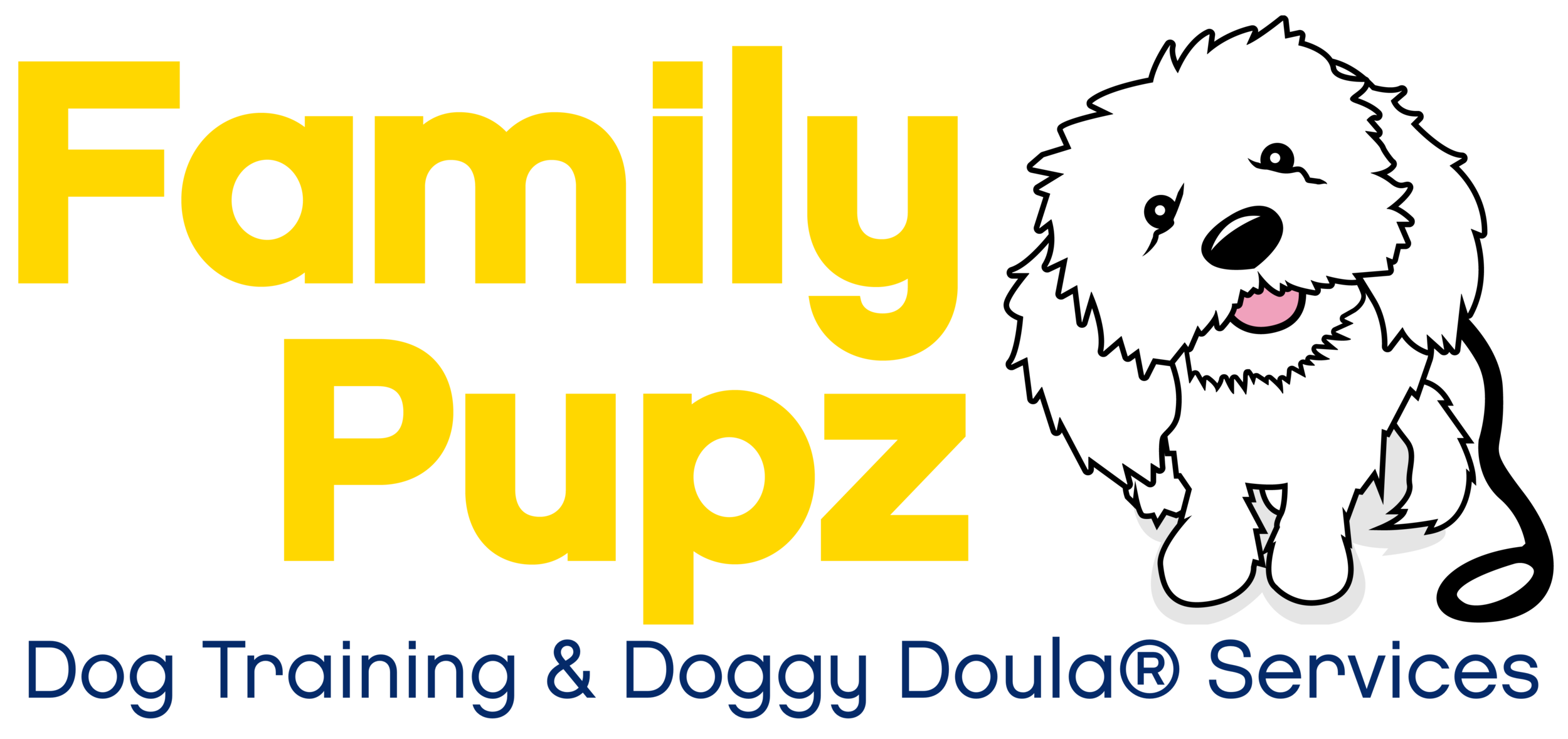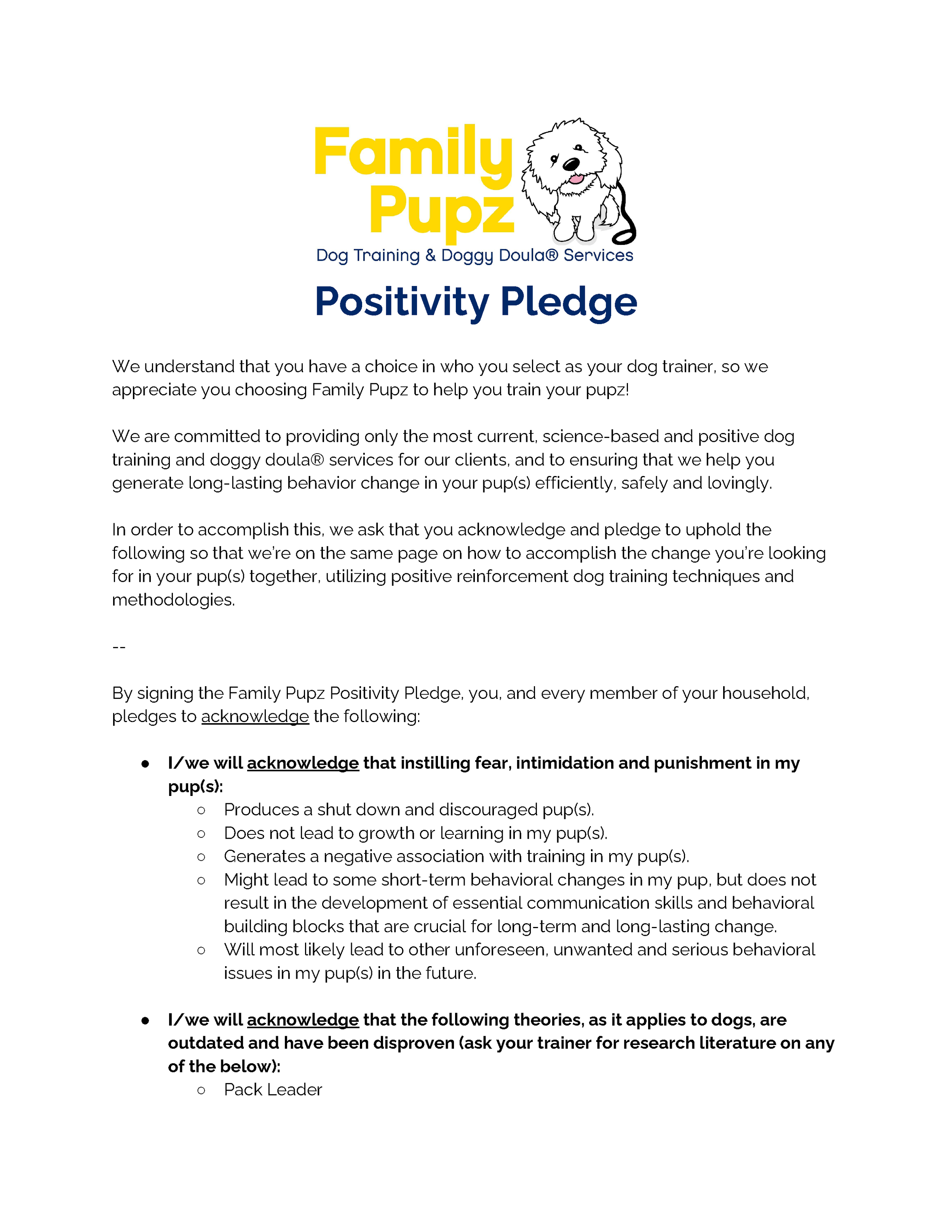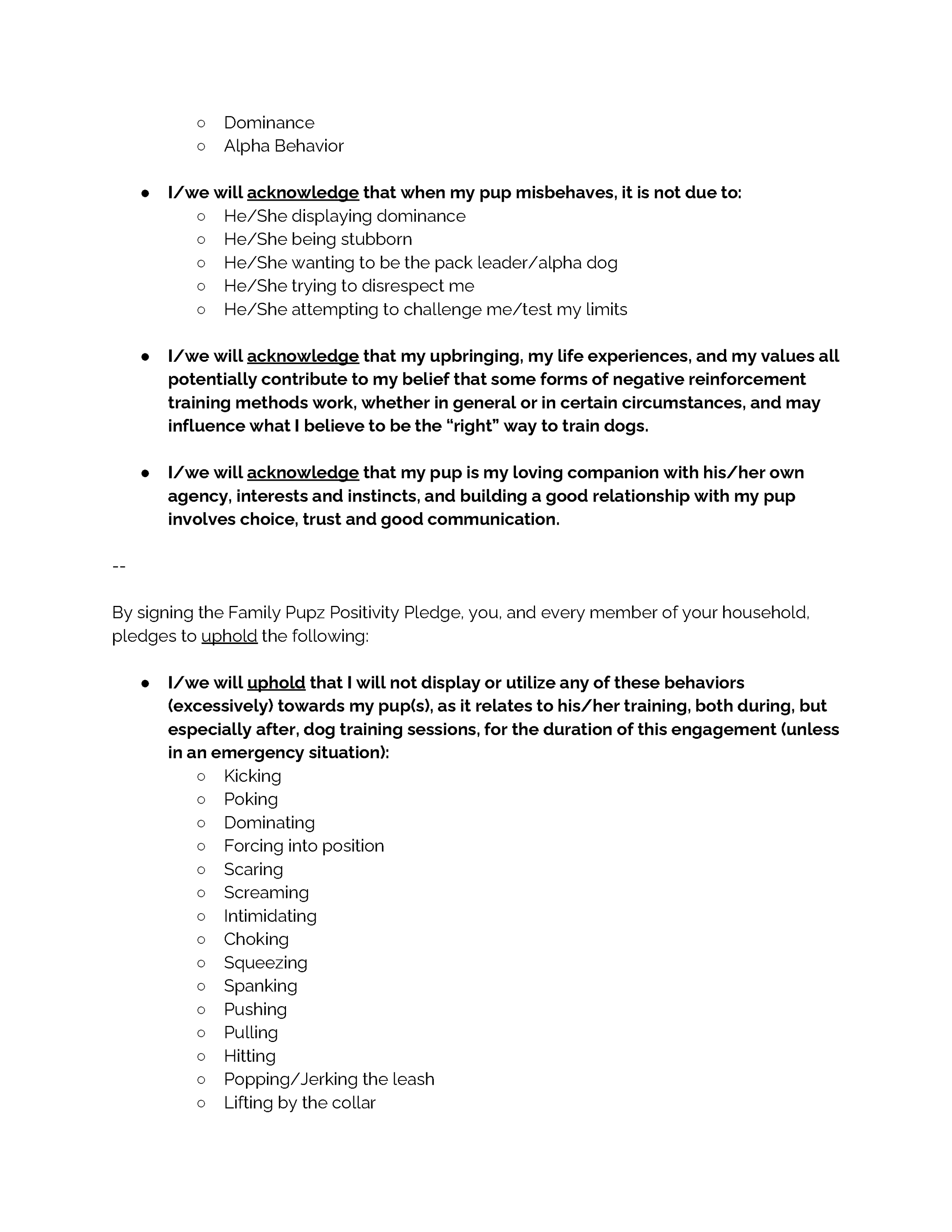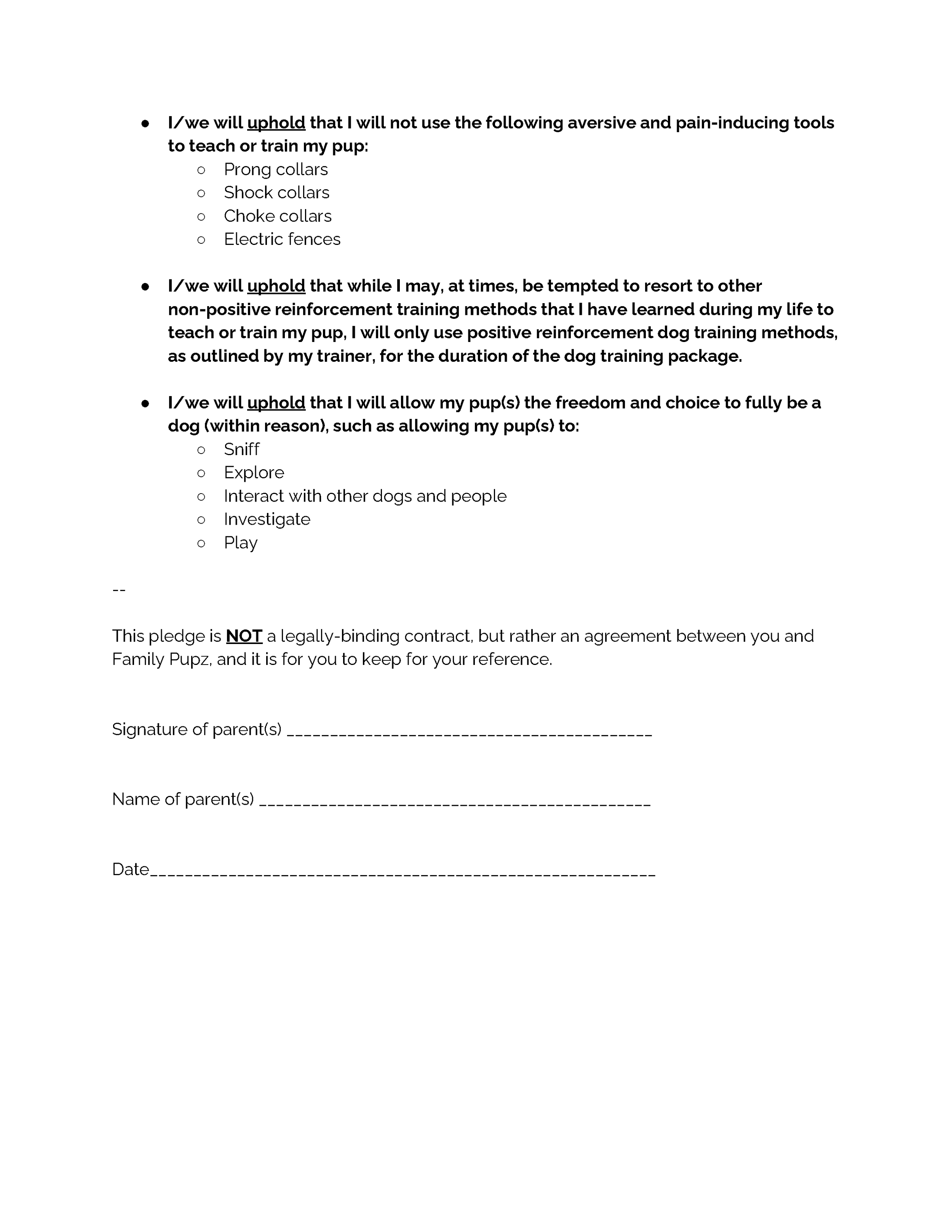Our Values & Principles: What “Because Training Your Dog Is Loving Your Dog” Means To Us
When my husband and I moved to Denver from New York City at the end of 2018, I immediately hit the ground running to build the dog training company that I’ve always dreamed of building.
I had already started training dogs for a few years as the founder of Play Pals, a dog walking and cat sitting company in London and New York City, because as any experienced dog walker will tell you, having a few dog training tricks up your sleeve makes your job a LOT easier.
But this time, I was ready to go all in on dog training.
Of course there was a lot to do, like picking our brand name, designing the logo, purchasing a domain, building a website, designing and printing business cards, introducing myself to, and creating relationships with, potential partners in the community, defining all company processes and procedures from scratch, and strategizing and executing a marketing plan, to name a few.
But before I did any of that, I really had to define and articulate what the guiding principles of our company were.
That’s because consumers today want and need to know who you are and what you stand for before buying anything from you. In a world of near infinite choice, consumers need to feel an emotional and value-driven connection with a company, so if you don’t put in the work to devise and communicate what drives and inspires you, it’s a near certainty that you’ll miss a ton of opportunities.
I mean, you certainly wouldn't start a relationship with someone you didn't have a connection with, right?
That’s why I believe that there’s no better way to do that than to really stand for a set of guiding principles that are AUTHENTIC, MEANINGFUL & BIG.
Yes, I wanted to build a dog training company.
Yes, I wanted to train puppies, adult dogs, and provide my doggy doula® services to expecting families.
But those were the “what”s, but what were the “why”s?
Our Guiding Principles
I knew a few things.
I knew that I wanted to be a fierce advocate for positive reinforcement dog training, not only for the sake of dogs, but (perhaps more importantly) for their parents, as well. It was the methodology that my mentors used, and it was, and continues to be, in complete alignment with my obsessive and undying love of dogs and all animals.
I also wanted to be a strong proponent of the idea that our behavior towards our dogs should be one based on building a true relationship with our dogs, rather than one based on ownership, where we demand obedience at every turn, and we are pleased with them when they do what we say, when we say it, and displeased when they don’t, because they somehow “owe us” for bestowing upon them shelter, food, toys, etc.
Lastly, I knew that I wanted to convey the idea that dog training is not optional. I believe that if you want to be a responsible dog parent today, and you choose not to train your dog (with a professional or on your own) because you think it’s a novelty, a nice-to-have, an extravagant luxury item (whether in dollars or in your time) that you could largely live without, or because you think that dogs are untrainable, and that getting a well-behaved dog depends solely on the luck of the draw, then you’re NOT BEING a responsible dog parent.
Communicating Our Guiding Principles
As any person who’s built a brand would tell you, it’s one thing to DEVISE a set of guiding principles, but another thing entirely to be able to COMMUNICATE those principles in a concise, hopefully memorable, and compelling way.
For these reasons, one of our first orders of business was to devise a tagline that encapsulated our guiding principles, not only to introduce and express ourselves to potential customers, but to establish a North Star, of sorts, to ensure that we continuously stayed true to our guiding principles for the long run, and to continually be inspired by them.
What The North Star Is
The North Star is famously the star in the sky that holds still while the entire northern sky moves around it. That’s because it’s located nearly at the north celestial pole, which is the point around which the entire northern sky turns, which is a very long way of saying that the North Star always marks the way due north, or, in this case, always keeps our long-term objectives in focus.
So, it makes rational sense that if you don’t have an awareness of what your true North Star is, it’s very easy to get rattled and batted about by the everyday currents, waves and tides of life, and unconsciously and gradually drift away from your original charted course, inch by inch, despite your best efforts, ultimately leaving you unable to “right the ship”.
Our Tagline
There is probably no more famous North Star tagline in the world than Nike’s, “Just Do It”.
For many of us, this is an aspirational tagline that succinctly conveys what Nike is about to many of us: winning, never giving up, trying new things, always striving, and getting better everyday.
As I was writing down those words and phrase above, I thought about the extent to which that tagline has completely embedded itself into our culture, as it only took a few seconds to rattle off the various meanings that those three words incite in me, and how much of an emotional impact those words have on my feelings towards the brand.
At the same time, it’s easy to imagine how powerful the tagline “Just Do It” can really be for the company itself, as it surely must guide all the decisions that the company makes internally.
I have no doubt, for example, that it influences which athletes/celebrities/teams that they work with, their corporate culture, the people they hire, and their business practices, whether they’re conscious of it or not.
—
So as my husband and I thought about how we could convey our guiding principles in a similarly concise and compelling way, he came up with a tagline that is still the defining tagline of our company today: “Because training your dog is loving your dog.”
I have to admit that when he first told me this tagline, I wasn’t very enthusiastic about it. I didn’t have anything against it, per se, but it just didn’t tug at me in a way that I thought hearing our company’s definitive tagline would.
But against my better judgment, I agreed, knowing that I could easily change it later, and I watched him add those 8 words to the header of our current website.
Then something interesting happened.
Time and time again, in my interactions with clients and their dogs, I was reminded how well that tagline represented us as a company.
That said, the alignment of our tagline, our guiding principles and our brand was more of a general feeling.
Like when you put on a piece of clothing and it just fits and looks perfect on you. You might not know why immediately, but if you sat and thought about it for a minute, you might realize that the color of the garment really complements your skin tone, for example, or that the style suits your personality, or that the fabric really balances out you silhouette.
Similarly, while I was being constantly reminded how well that tagline works for us, I never took the time to really think about, dissect, and put to paper all the reasons why our tagline expresses our guiding principles so well, or to outline how that tagline helps us stay true to who we are in everything that we say and do as a company.
Until now.
(I feel a little bit like Tom Cruise when he wrote his “mission statement” in Jerry Maguire, lol)
What Our Tagline Means To Us
Positive Reinforcement Dog Training
How That Represents Us
More than anything, we believe that training your dog is synonymous with loving your dog. Furthermore, we believe that positive reinforcement dog training, rooted in trust, choice and good communication, is the most loving way to train your dog.
At its core, that means that we NEVER use any training techniques that involves fear, intimidation or punishment to achieve the behavioral changes we’re looking for in our pupz, not only because we think that this is the moral and responsible way to train, but because the studies that are most commonly quoted to justify more coercive methods, such as pack leader, dominance and alpha theories, have largely been disproven, akin to trying to understand how humans behave by studying how they act in refugee camps.
Furthermore, not all behavior change is the same.
We can all intrinsically understand, as humans, that when others try to coerce us through fear, intimidation or punishment, they can (with varying degrees of success) get the behavior changes in us that they want.
But I think that we can all agree that while the resultant behavior changes might LOOK the same from the outside as those derived through trust, choice and good communication, it can FEEL different to us internally, which can result in irreparable changes to how we view learning, trying, and the relationship as a whole,
Dogs are no different.
How That Inspires/Guides Us
While it’s easy to say that we pledge to NEVER use training techniques that involve fear, intimidation and punishment, what does that mean in practice?
First of all, that means that we do not encourage, advocate for, overlook or allow the following acts designed to instill fear, intimidation and punishment, as part of our training program and for the entire duration of it, and hopefully after it, such as:
Kicking
Poking
Dominating
Forcing into position
Scaring
Screaming
Intimidating
Choking
Squeezing
Spanking
Pushing
Pulling
Hitting
Popping/Jerking the leash
Lifting/Dragging by the collar
This also applies to the training equipment, tools and items that are specifically-designed to use fear, intimidation and punishment to achieve the desired behavioral change, such as prong collars, shock collars, electric fences, etc.
Fortunately, large companies like Petco enthusiastically agree, as they’ve recently launched a bold “Stop The Shock” campaign, where they have announced that they are:
“out with shock collars and in with POSITIVE TRAINING [with] expert trainers who mentor pets and pet parents with positivity, patience and compassion.”
We couldn’t have said it better ourselves.
It also means that we refuse to work with customers, partners, businesses and organizations that do not wholeheartedly believe in positive reinforcement dog training techniques.
That said, we understand that everyone has blind spots, and that so much of learning involves unlearning a host of things first.
That’s why we’ve recently began distributing our Positivity Pledge that we have all new clients sign, that not only outlines a host of behaviors that we expect our clients to uphold, but also to acknowledge a few things that they might not necessarily know, through no fault of their own, which you can find below, to ensure that we’re explicitly on the same page from day one (click on the pdf below to view the other pages of the Positivity Pledge).
Building a True Relationship With Our Dogs
How That Represents Us
As mentioned above, it’s vitally important to us to convey the idea that our goal with training is to help build a true relationship between dog and dog parent, rather than one based on ownership, obedience and dominance.
That means that we view training as a way to teach our pupz how to be a GOOD DOG in our alien (to them) HUMAN world, while simultaneously allowing them to fully be who they are: an endlessly curious, excitable, exuberant, devoted, and playful LIFE COMPANION.
How That Inspires/Guides Us
While it’s easy to say that we strive to build a true relationship with our dogs, what does that mean, exactly, in practice?
First of all, it completely upends how we talk about our dogs, our actions towards them, and our relationship to them.
For example, if we vow to view our dogs as our life companions instead of our possessions, the words that we use necessarily change, such as:
“Caretaker/Parent/Paw-Rent”, instead of “Owner”
“Reinforcer/Reward”, instead of “Bribe”
“Cues”, instead of “Commands”
“Perform”, instead of “Obey”
“Advocate”, instead of “Alpha”
“Unsure”, instead of “Stubborn”
“Consequences”, instead of “Corrections”
“Learning”, instead of “Misbehaving”
And while some may question how merely changing a few words can help us build a true relationship with our dogs, I invite you to think about the jumping dog below.
One way you can interpret what’s going on above is by using the words, “my dog is crazy and is uncontrollable.”
Another way to describe it is by using the words, “my dog is really exuberant and energetic.”
You see how these two phrases, utilizing different words, can have such power over the stories that we tell ourselves about what’s going on in front of us?
The first phrase conjures up feelings of impotence, frustration, shame and misfortune. And these feelings really affect how we view the world, our circumstances, and especially how we view and treat our dogs.
The second phrase, on the other hand, conjures up feelings of opportunity, humor, and detachment. And these feelings, too, affect how we view the situation in front of us..
In short, changing the words that we use can have a profound affect on how we think about our reality and especially how we view our dogs, especially when they “misbehave”.
Instead of viewing their misbehavior, for example, through the lens of them trying to assert dominance over us, frustrate, disrespect and/or challenge us, I invite you to view their misbehavior as them trying to cope with, understand, and explore our world, and the myriad of unspoken and spoken rules of human society that we might know intimately, but your dog might not yet.
When we view their “misbehavior” through that lens, its very easy, then, to view it as an opportunity to teach, guide and coach them, as well as to provide them with enrichment activities to engage their brain and to let them have fun.
If your toddler, for example, was throwing a tantrum because he was bored, hungry, or scared, you wouldn’t view his actions as trying to assert dominance over you, right?
Furthermore, in the midst of that tantrum, wouldn’t you try to understand the cause and attempt to soothe, engage and love him?
—
Another way that we encourage building a relationship with our dogs is to give them the space, room, and freedom to be who they are: a DOG!
What that means in practice is that we highly encourage our clients to give their dogs ample opportunity to sniff, explore, interact with other people and dogs, investigate, express themselves and play, instead of merely viewing our dogs’ lives as an inflexible extension of our own desires, needs, schedule and whims.
More concretely, this might mean taking your dog out for a walk a little earlier than normal so that when your dog wants to go in this direction or that, you’re not frustrated by him because his actions are interfering with your precisely timed and mapped-out walk.
And the positive effects of building a true relationship with your dog flow BOTH WAYS.
Specifically, when you actively prioritize your dogs needs and desires, you free yourself from the shackles of seemingly uncontrollable and unnecessary frustration and anger towards your dog because you have come to believe that he’s trying to make your life difficult on purpose.
And lastly, I like to encourage my clients to make training fun, instead of looking at it like a chore. By playing a variety of games in different environments using fun toys and a plethora of delicious, healthy and highly-motivating organic and single-ingredient treats, this will only help you build a stronger relationship with your life companion.
Training is Not Optional
How That Represents Us
Lastly, our biggest goal is to elevate dog training to become an unequivocally vital part of being a RESPONSIBLE AND LOVING dog parent, just as providing food, medical/dental care, socialization, grooming and walking have become widely understood to be what a responsible and loving dog parent needs to do for their dog.
Why, you ask?
Because training your dog contributes greatly to the mental health of your dog. It’s through establishing a clear channel of communication with our dogs that we can help them successfully navigate and thrive in our world, no matter the circumstance, contributing to his overall happiness and confidence, and yours!
And when you can establish this synchronous relationship, dog parenthood can reach new highs previously unimagined, as many dog parents already know intimately.
How That Inspires/Guides Us
Obviously, providing our dog training services to as many people as we can is the primary way that we are guided by this principle.
That said, we understand that our private in-home dog training services are not accessible to everyone, so we make every effort to create and provide information/experiences to those that need it, no matter what their situation is, which you can find here.
In Conclusion
It’s not the easiest thing to express what’s in your heart, but I think I did just that above, at least as it pertains to what the values and principles of our company mean to us.
That said, while proofreading the post, I noticed how much the human end of the leash I took into account.
This is because I know many of you feel deeply uncomfortable with the training methodologies that are more rooted in fear, intimidation and punishment, but feel like (through no fault of your own) they must be the right way to do things because a “professional” told you so.
This is because I see many of you wince when you see some people using these aversive tactics on their dog, but you don’t believe that it’s within your right to say or do anything about it, because you believe that it’s still the dog parent’s right to teach him like that.
And this is because I know that many of you feel like using punishment-based methods is completely incongruous with your personal values, principles, and how you view and engage with every other part of your life.
--
I’m here to tell you that those feelings inside of you are trying to tell you something that you already know: That there must be a better way.
By taking dog training seriously, by prioritizing your dog’s needs and desires to build a true relationship with your dog and by using a training methodology rooted in trust, choice and communication, I promise you that you can achieve (with time and patience) all the training goals you have for your dog!
Of course, you don’t have to do this alone. Contact us to find out how we can support your journey as a doggy parent!
For additional information on this topic, we’ve created an accompanying podcast episode on this very subject, which you can listen to below:













